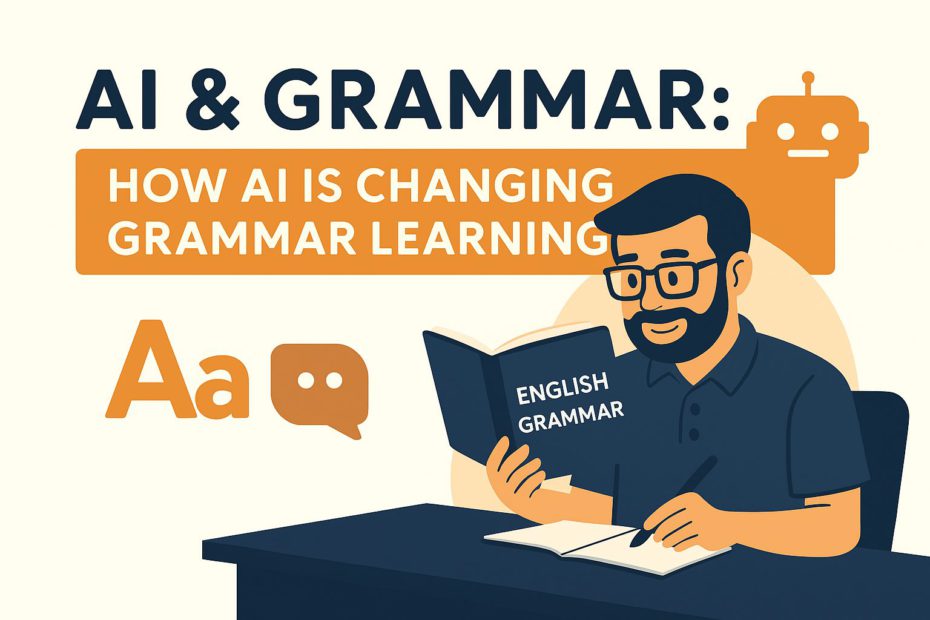Let’s be real, grammar rarely tops anyone’s list of thrilling pastimes. For most of us, it meant slogging through endless rules, sketching sentence diagrams, and wincing at those dreaded red pen marks. Not exactly a party, huh?
Well, not anymore. The landscape of grammar learning has shifted dramatically.
But things have changed. Artificial Intelligence (AI) has given grammar learning a serious makeover. What was once tedious now feels interactive, genuinely helpful, and, believe it or not, almost fun.
Remember the Old-School Way?
If you grew up doing grammar exercises in a dusty workbook, you’re not alone. Teachers explained the rules, and we wrote them down. Rinse, repeat. Some of us got it; some of us didn’t. And if English wasn’t your first language? Forget it, grammar could feel like learning math with letters.
There was always that one confusing moment: “Wait, what’s the past perfect continuous again?”
Back then, you either cracked the code or crossed your fingers, hoping spellcheck would come to the rescue.
Enter AI: The Not-So-Secret Weapon
Fast-forward to now: tools like Grammarly, ChatGPT, and Duolingo help with grammar 24/7. These tools are always on and ready to underline your sentences or suggest better ways to say, “I go to school.”
Some of the heavy hitters:
- Grammarly: It’s like having an English teacher in your browser.
- ChatGPT: Ask it anything, and it’ll explain grammar like your smart friend who never runs out of patience.
- Quillbot: Need to rewrite something without sounding like a robot? This one’s a lifesaver.
- Duolingo: You’ll be learning grammar and not even realize it, thanks to those sneaky owl reminders.
So, Is It Better Than a Real Teacher?
AI isn’t a replacement for real teachers, but it is a powerful support for learning grammar independently.
What AI does really well:
- It doesn’t judge. You can make 15 grammar mistakes in one paragraph, and it’ll still help.
- It’s instant. You don’t need to book a tutor or wait for feedback.
- It’s accessible. Whether you’re in New York or a small village in Pakistan, if you’ve got Wi-Fi, you’ve got grammar help.
Still, AI isn’t flawless. Sometimes, its advice misses the mark, or it “fixes” a sentence that was perfectly fine. Then again, don’t we all have off days?
The Best Part? It Actually Teaches You
Here’s the cool thing: the best AI tools don’t just fix your grammar, they show you why something’s wrong. Over time, you start noticing patterns. You begin catching your own mistakes before the AI does.
That’s when you know it’s working.
I’ve seen ESL students go from shaky paragraphs to solid essays by consistently and thoughtfully using AI tools. There’s a difference between hitting “Accept” blindly and actually reading the explanation and learning from it.
But before you get too comfortable, let’s talk about what AI can’t do.
AI can’t teach tone. It doesn’t know your voice. While it can correct grammar, it might suggest sentences that feel stiff, overly formal, or just not like you. AI sometimes overlooks context or intent, so its suggestions may not always fit your writing style or the message you want to share.
Plus, lean too hard on AI and you might stop actually thinking about grammar. If you rely only on automated suggestions without understanding why, your writing growth can stall. AI can’t replace the critical thinking needed to truly master language usage.
And let’s not ignore the obvious: relying on AI to complete your entire assignment? That’s a slippery slope. That’s not helping your brain grow. That’s cutting corners, and trust me, it shows.
Real-Life Use Cases (No Hype)
- A friend of mine runs a tutoring center. She uses Grammarly to give students a second opinion before they hand in their essays.
- I’ve helped someone prep for an IELTS exam using ChatGPT to generate grammar quizzes on the fly.
- One guy I know used Quillbot to rewrite his entire blog to sound more natural and saw his bounce rate drop like a rock.
These tools aren’t just for students. Bloggers, business owners, job applicants, everyone is using AI to tighten up their writing.
Looking ahead, let’s consider where grammar and AI are heading together.
As AI gets smarter, I imagine tools that can:
- Imagine getting grammar feedback as you talk, like having a clever language coach whispering in your ear.
- Track your grammar mistakes across months and tell you what to focus on.
- Adapt your writing to your goals, whether you want to sound more academic, casual, or persuasive.
Honestly? That’s the kind of future that makes learning grammar feel fresh instead of frustrating.
TL;DR: Use AI Smartly, Not Lazily
Here’s what I tell anyone who asks:
Use AI like a GPS for writing.
It’ll guide you, but you still need to understand the road.
So next time Grammarly underlines something, don’t just click “Fix.” Pause. Read. Ask yourself why. That’s where the real learning happens.
AI is a valuable companion, but you are the writer. Own your sentences, use tools to learn actively, and make sure AI supports, not replaces, your growth.
Want more?
- Need grammar examples explained like you’re five? I’ve got you.
- Want to create a grammar quiz with AI? I’ll show you how.
- Curious how to write with tone and accuracy? Let’s talk style.
✍️ Final Thought
Grammar goes beyond rules; it’s the key to expressing yourself clearly, confidently, and meaningfully. And now, thanks to AI, learning it doesn’t have to be so hard.
Use it. Explore it. But don’t forget to think like a human because that’s what AI can’t do (yet).
